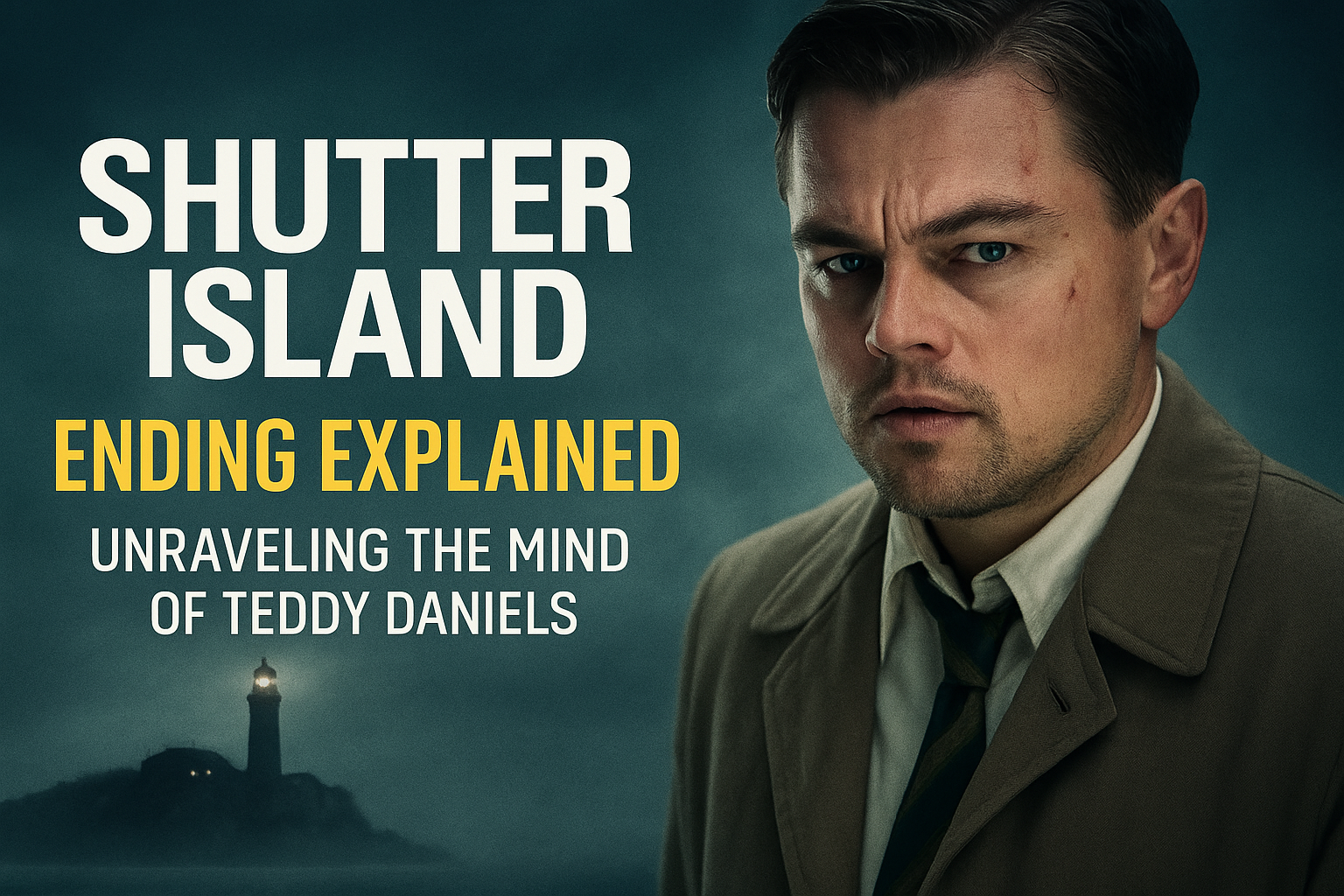
Martin Scorsese’s Shutter Island (2010) is a gripping psychological thriller that has kept viewers questioning its twist for years. Based on Dennis Lehane’s novel, the film stars Leonardo DiCaprio as U.S. Marshal Teddy Daniels investigating the disappearance of a patient from Ashecliffe Hospital — but the ending flips the story on its head.
Shutter Island Ending Explained – Reality, Delusion, or a Masterful Bluff?
Let’s dive into the unraveling mystery and what the ending really means.
Plot Recap – The Setup of Illusion
Leonardo DiCaprio plays Teddy Daniels, a U.S. Marshal who arrives at a remote mental institution with his partner, Chuck (Mark Ruffalo), to investigate the disappearance of a patient named Rachel Solando. As Teddy digs deeper, he begins to suspect unethical experiments and a conspiracy involving the staff.
However, strange dreams and flashbacks hint that Teddy may be losing grip on reality. As he spirals, the line between hallucination and truth begins to blur.
The Big Reveal – Who Is Teddy Daniels Really?
In the final act, Dr. Cawley (Ben Kingsley) drops a bombshell: Teddy Daniels is not real. His real name is Andrew Laeddis, a patient at the asylum for the criminally insane.
Andrew was committed after murdering his manic-depressive wife Dolores, who drowned their three children. His “investigation” was actually a role-play experiment created by the doctors as a last-ditch attempt to break through his delusion.
Chuck is revealed to be Dr. Sheehan — Andrew's psychiatrist — playing along to observe whether the treatment will succeed.
Was It All in His Head? Yes... and No
Yes, Andrew/Teddy was living in a carefully constructed fantasy. He created the identity of Teddy Daniels to avoid the trauma of killing his wife and losing his family.
The names are even symbolic:
- Teddy Daniels = an anagram of Edward Daniels
- Rachel Solando = an anagram of Dolores Chanal
But even after the truth is laid bare, Andrew’s grip on reality remains fragile.
The Final Scene – A Line That Changes Everything
After the role-play, Andrew appears lucid. He talks to Dr. Sheehan about “getting off the island” — implying he accepts reality.
But then he utters this haunting line:
“Which would be worse: To live as a monster, or to die as a good man?”
This is the key to the ending.
Ending Interpretations – Two Powerful Theories
1. He Relapsed
This is the official reading: Andrew briefly gained clarity but slipped back into delusion. His trauma is too deep, and the doctors conclude that the experiment failed.
He’s lobotomized, ending the cycle of violence and pain.
2. He Pretended to Relapse
This theory, widely debated by fans, suggests Andrew pretends to relapse. He remembers everything, but chooses to be lobotomized because he can’t live with the guilt.
The final line is a cryptic farewell — a man choosing peace over truth.
This theory positions Andrew as the film’s true tragic hero, making a conscious, self-sacrificial choice.
Symbolism in the Ending
- The Lighthouse: Represents enlightenment, truth, and exposure. Once feared as a place of torture, it becomes the site of revelation.
- Water: Constantly linked to trauma (drowning of his kids) and represents emotional depth and denial.
- Fire: Used in hallucinations — symbolizes illusion and destruction of memory.
- Stairs & Spiral Shots: Reflect Andrew’s mental descent and cyclical delusions.
Themes in the Finale
Trauma & Denial
Andrew’s psyche created Teddy as a coping mechanism. The mind’s ability to protect itself through delusion is at the heart of the film.
Guilt & Redemption
Whether he accepts his truth or not, Andrew is haunted by guilt. The ending may be his way of finding peace — even through destruction.
The Ethics of Psychiatry
The doctors’ elaborate role-play raises questions: was it therapy or manipulation? Did they truly try to help — or break — him?
Fan Reactions & Theories
- Some fans argue the movie deliberately keeps things ambiguous — Scorsese never confirms either theory.
- Others believe Scorsese leans toward the “pretending” theory, citing DiCaprio’s subtle final expressions.
- Reddit debates often center around body language in the final scene — is the cigarette a clue?
Final Thoughts
Shutter Island is a masterclass in psychological storytelling. Its ending delivers not just a twist, but a tragic emotional punch.
Whether Andrew Laeddis chose to forget or genuinely couldn’t accept the truth, his story is one of deep human pain. The island becomes a metaphor for isolation — not just physically, but mentally.
It's not about whether he was sane or not — it’s about what sanity means when guilt is unbearable.
FAQs
Q: Was Teddy Daniels real?
A: No. He was a persona created by Andrew Laeddis, a patient at Ashecliffe.
Q: What does the lighthouse represent?
A: It symbolizes truth and the final confrontation with reality.
Q: Did Andrew choose to be lobotomized?
A: Possibly. His final line suggests he may have pretended to relapse as a way to escape his guilt.
Q: Is Shutter Island based on a true story?
A: No. It’s adapted from a novel by Dennis Lehane.
Q: Why is the ending so ambiguous?
A: Director Martin Scorsese deliberately leaves it open to interpretation, allowing viewers to choose the truth that resonates most.




